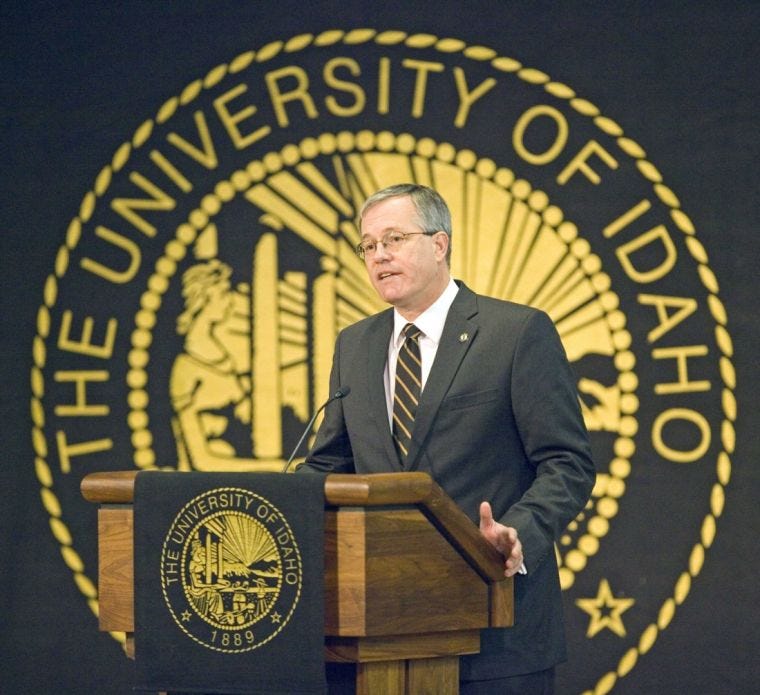
This time of year many high school students are weighing their options for college. For most people getting a college degree is the difference maker in getting a good job and opportunities for a satisfying life. Seeing themselves in the opportunity-making business, Idaho public colleges are now automatically admitting high school seniors with a 3.0 or higher grade point average and SAT score of at least 1000.
It is a brilliant idea, particularly for a state that lags far behind other states in college-going rates.
Instead of the typical strategery and scramble to increase enrollment, University of Idaho’s president, Chuck Staben bypassed the step altogether, notifying all 20,171 graduating high school seniors that they are automatically accepted in the state’s public colleges and universities.
The new automatic or “direct” enrollment initiative comes at a time college enrollment among low-income students nationally is dropping.
Even though high school graduation rates are improving and student aid money doubled, college enrollment among students in the lowest income bracket dropped by 10 points, from 56 percent to 46 percent. The percentage of all high school graduates who went straight to college dipped by three percentage points between 2008 and 2013.
The “automatic in” makes abundant sense, removing a key barrier to college. Idaho and Rhode Island are the only states without divided education governance. With only one entity overseeing all public education from kindergarten to college, sharing relevant student records such as grades, names and addresses is made much easier.
Will Idaho take this opportunity to make the rest of students’ higher education experience just as seamless as their enrollment? What can the nation learn from their example?
Educators all share the same students, just at different points in their education journey.
Too often higher education makes students walk the plank, dropping out without a degree and often with significant debt. According to an ACT report, only about 46 percent of 2014 graduates were considered college-ready. More than 50 percent of students entering two-year colleges and nearly 20 percent of those entering four-year universities are placed in remedial classes.
The primary reason is that what is taught at the K-12 levels is not aligned with what students will need to know and do to succeed in college.
Balkanized by inertia and a lack of awareness, K-12 and higher education are causing serious harm to the students they share when they operate independently.
The failure to link what is taught in K-12 grades to college entrance expectations reverberates through a student’s life — and hurts the nation’s economy. This can change.
We have firsthand experience in seeing the simple act of K-12 and higher education faculty and administrators coming together to review student performance data and observations about student needs. It is eye opening for both K-12 and college educators. Faculty discover that while they both may be calling a subject Algebra or English, what is taught and assigned can be very different, setting up students for a struggle.
Consider what happened in southern California, when high school teachers and college faculty members participating in the English Curriculum Alignment Project (ECAP) discovered gaps between what was taught in high school English and what was expected in college English. They learned that high school teachers were mostly teaching literature, focusing on characters and story lines in classic works of fiction. English instructors at the college level were focused on teaching students about argumentation and writing clearly to inform, persuade and describe — key skills needed to succeed at work, think critically and contribute to the community. Recognizing this disconnect, teachers worked to better align their teaching, giving students more opportunities to develop the writing and analytical skills they needed for college and careers.
As a result, 86 percent of students kept on course to successfully complete college-level English. In contrast, only 24 percent of students placed in the lowest level of English remedial courses in California colleges ever make it out.
In the Texas gulf region, faculty and school leaders from community college and school districts took alignment a step further, developing practical tools to align what is taught and put students on a path for success.
The Texas Gulf Coast Partnership for Achieving Student Success (GC PASS) project created curriculum alignment guides to bridge K-12 and higher education math and English to help students successfully transition from high school through college degree completion. Gulf region students are now experiencing a more seamless sequence of lesson plans, assignments and course materials that prepare them for success in college. Just one year into the effort, college-going rates increased 10 percent. Success in remedial math improved 18 percent
There are signs of a tipping point toward support for secondary and post-secondary education systems working together.
A new report from Education Commission of the States, Aligning K-12 and Postsecondary Career Pathways with Workforce Needs, examines the policy efforts in 13 states to improve alignment.
A series of reports produced by Jobs for the Future is aimed at getting K-12 and higher education to recognize a “shared transition zone, where both systems assume responsibility for college readiness and success, and where they collaborate in key ways to substantially increase the number of youth truly prepared for college and careers.”
This focus is significant, because it resists the fads and fancies that blow through education on a regular basis, or small-scale, albeit laudable programs like dual enrollment or early college high school, and instead focuses on systemic reform that joins educators at all levels to pull in the same direction. While intensive, these collaborations are extraordinarily uncontroversial and universally supported by teachers and administrators. In a partisan, highly-charged political environment, the time has come for the common sense, unifying solutions to prevail.

